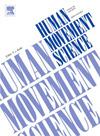Effect of perturbation-based balance training distribution on stability and fall risk in faller older adults: A randomized single-blind clinical trial
IF 1.9
3区 心理学
Q4 NEUROSCIENCES
引用次数: 0
Abstract
Falls are the leading cause of injury among older adults, often occurring during walking. Effective training programs are essential for reducing falls, and the distribution of practice may influence motor skill learning. This randomized clinical trial investigated the effects of different perturbation-based balance training (PBT) session distributions on postural stability and fall risk in older adults with a history of falls. Thirty participants were randomly allocated to either a massed practice group (2 sessions/day; n = 15) or a distributed practice group (1 session/day; n = 15). Both groups underwent four PBT sessions involving acceleration and deceleration perturbations, followed by a retention test one week later. We assessed the margin of stability (MoS), the number of falls during sessions, and dynamic balance using the Mini-BESTest before and after training. Assessments were performed by evaluators blinded to group allocation. Groups did not differ in any of the variables investigated. Significant improvements were observed in MoS during the deceleration perturbation sessions (p < 0.05), with an increase between sessions 1 and 4, and between session 1 and the retention test (p < 0.05). The number of falls was reduced over the sessions (p < 0.001), and there was an improvement in dynamic balance in the Mini-BESTest after PBT, particularly in reactive control and gait dynamics (p < 0.001). The distribution of PBT sessions, whether massed or distributed, did not affect fall-related outcomes in fall-prone older adults. These findings support the use of flexible PBT schedules for fall prevention. This trial was registered in the Brazilian Clinical Trials Registry (RBR-9dhx6kj; UTN: U1111–1276-4396).
基于微扰的平衡训练分布对老年人稳定性和跌倒风险的影响:一项随机单盲临床试验
跌倒是老年人受伤的主要原因,经常发生在走路时。有效的训练计划对于减少跌倒是必不可少的,练习的分布可能会影响运动技能的学习。这项随机临床试验调查了不同基于扰动的平衡训练(PBT)时段分布对有跌倒史的老年人姿势稳定性和跌倒风险的影响。30名参与者被随机分配到集中练习组(2次/天,n = 15)和分散练习组(1次/天,n = 15)。两组都进行了四次PBT测试,包括加速和减速扰动,一周后进行记忆力测试。我们在训练前后使用mini - best评估了稳定度(MoS)、训练期间跌倒次数和动态平衡。评估由对分组分配不知情的评估者进行。各组在调查的任何变量上都没有差异。在减速扰动过程中观察到显著的改善(p < 0.05),在第1和第4阶段之间以及在第1阶段和保持测试之间观察到显著的改善(p < 0.05)。在治疗过程中跌倒次数减少(p < 0.001), PBT后mini - best患者的动态平衡有所改善,特别是在反应性控制和步态动力学方面(p < 0.001)。在容易跌倒的老年人中,PBT的分布,无论是集中的还是分散的,对跌倒相关的结果没有影响。这些发现支持使用灵活的PBT时间表来预防跌倒。该试验已在巴西临床试验登记处注册(RBR-9dhx6kj; UTN: U1111-1276-4396)。
本文章由计算机程序翻译,如有差异,请以英文原文为准。
求助全文
约1分钟内获得全文
求助全文
来源期刊

Human Movement Science
医学-神经科学
CiteScore
3.80
自引率
4.80%
发文量
89
审稿时长
42 days
期刊介绍:
Human Movement Science provides a medium for publishing disciplinary and multidisciplinary studies on human movement. It brings together psychological, biomechanical and neurophysiological research on the control, organization and learning of human movement, including the perceptual support of movement. The overarching goal of the journal is to publish articles that help advance theoretical understanding of the control and organization of human movement, as well as changes therein as a function of development, learning and rehabilitation. The nature of the research reported may vary from fundamental theoretical or empirical studies to more applied studies in the fields of, for example, sport, dance and rehabilitation with the proviso that all studies have a distinct theoretical bearing. Also, reviews and meta-studies advancing the understanding of human movement are welcome.
These aims and scope imply that purely descriptive studies are not acceptable, while methodological articles are only acceptable if the methodology in question opens up new vistas in understanding the control and organization of human movement. The same holds for articles on exercise physiology, which in general are not supported, unless they speak to the control and organization of human movement. In general, it is required that the theoretical message of articles published in Human Movement Science is, to a certain extent, innovative and not dismissible as just "more of the same."
 求助内容:
求助内容: 应助结果提醒方式:
应助结果提醒方式:


